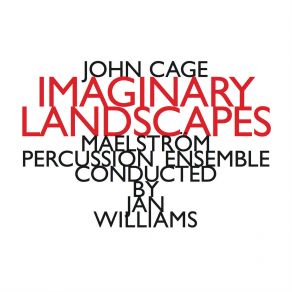John Cage: Imaginary Landscapes
Download links and information about John Cage: Imaginary Landscapes by John Cage, Jan Williams, Maelström Percussion Ensemble / Maelstrom Percussion Ensemble. This album was released in 2001 and it belongs to Classical genres. It contains 6 tracks with total duration of 51:15 minutes.

|
|
|---|---|
| Artist: | John Cage, Jan Williams, Maelström Percussion Ensemble / Maelstrom Percussion Ensemble |
| Release date: | 2001 |
| Genre: | Classical |
| Tracks: | 6 |
| Duration: | 51:15 |
| Buy it NOW at: | |
| Buy on iTunes $9.99 | |
Tracks
[Edit]| No. | Title | Length |
|---|---|---|
| 1. | Imaginary Landscape No. 1 (1939) | 8:45 |
| 2. | Imaginary Landscape No. 2: March No. 1 (1942) | 6:35 |
| 3. | Imaginary Landscape No. 3 (1942) | 3:05 |
| 4. | Imaginary Landscape No. 4: March No. 2 (1951) | 5:00 |
| 5. | Imaginary Landscape No. 5 (1952) | 1:50 |
| 6. | But What About The Noise... (1985) | 26:00 |
Details
[Edit]In 1964 John Cage and David Tudor set up shop in Los Angeles' Feigen-Palmer Gallery, equipping two rooms with complete sound systems (recording and mixing equipment, numerous radios, tape players and record decks to be used by carefully supervised operators) and placing microphones strategically inside and outside the building (one was suspended above the bar, another out in the street to catch the passing traffic), before embarking on a monumental six-hour performance of Cage's "Variations IV," excerpts from which were edited and mixed down to stereo for Everest, resulting in an album that proved so scandalously successful that a second volume was subsequently released. One suspects that, in accordance with the prevailing zeitgeist, the "operators" here were rather more inclined to include pop and classical found objects than accept the presence of "noise," though the resulting mix must have met with the approval of Cage (despite his complaining once that performers of his legendary 1951 piece for twelve radios "Imaginary Landscape N°4" were more disposed to tuning in to established stations rather than accepting the vagaries of static and crackle between them). What results then is a chaotic, hilarious but ultimately rather frustrating hotchpotch of almost every conceivable kind of (predominantly) Western music: from chestnuts like "Bolero" and "The Nutcracker" via Russian basso profundo and screaming coloratura divas to Dixieland, bebop, Christmas carols, horror movie soundtracks, bagpipers and some decidedly tongue-in-cheek pilfering from old BBC radio dramas, plus a snatch or two of Cage's own "String Quartet." It's a perfect period piece worth seeking out as much for its far-sighted and informative liner notes by Joseph Byrd as for the "music" it contains.